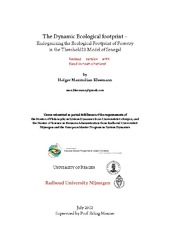| dc.description.abstract | Many countries in the world are in ecological overshoot. That is the message that the Ecological Footprint calculated by the Global Footprint Network sends us. Since many developing countries may not be in overshoot yet, but are heading for it, it is very important that their development paths leapfrog to resilient sustainable development. But what are the policies that could bring developing countries on such desirable paths? The Ecological Footprint cannot give a good answer to such questions because as an ecological accounting tool, it is intrinsically of an expost nature. The Threshold 21-models have been developed by the Millennium Institute for the precise purpose of allowing for sustainable national development planning using System Dynamics as a method suited for long-term policy analysis in these highly complex dynamic systems. But these models currently lack the Ecological Footprint and can therefore not be used to analyze the effect of policies on it. This thesis is a pilot project assessing to what degree it could be possible to implement a dynamic version of the forest Ecological Footprint (and the forest biocapacity) in the T21-model of Senegal. It was found that while it is possible to implement a dynamic forest Ecological Footprint in T21-models, it requires a great deal more of additional information that is neither contained in the accounting methodology of the Ecological Footprint nor in the existing T21-models and that is also hard to find in publically available sources. As a result, the current endogenization state of the forestry Ecological Footprint is still limited and needs to be elaborated to allow for meaningful future projections with the help of on-the ground forestry experts in Senegal. Nevertheless the project has already lead to suggestions for improvements for the GFN methodology and the T21-model: Switching the calculations from a constant to a variable annual forest increment is the most pressing issue, as the current constant approach implies a gross underestimation of the overshoot situation. This paper also makes suggestions of how this data could be obtained. The T21-model should be extended by a conversion flow from forest land to cropland. This implies that the main forest policy spear-head in Senegal, the fuel-switch campaign to butane, may stay limited in its effect on arresting forest decline even if it is in itself successful. That is because the timber from these converted areas may in part be harvested and pushed as charcoal on the market rather than harvest following demand. Furthermore, as some of the timber removed in these conversions may not be harvested, it does not show up in the harvest data and consequently also hides itself from the calculation of the Ecological Footprint. The same problem concerns the timber removed by anthropogenic forest fires. Overall, the implementation of the whole Ecological Footprint in T-21 is highly recommendable not only for the original purpose of enabling ex-ante policy analysis concerning sustainable resource use, but also because both the T21-model and the accounting methodology of the Ecological Footprint will both benefit from it in many less expected ways. | en_US |
